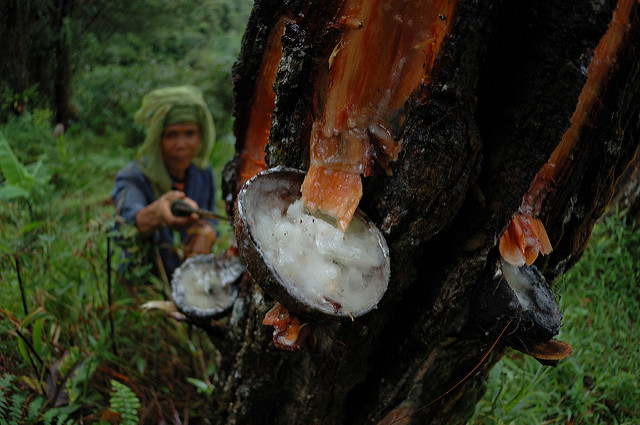
The effective use of tree genetic resources is crucial to bridge production gaps, ensure profitability and diversify production options. This has, for example, been highlighted by the Global Action Plan for Agricultural Diversification (GAPAD). If we use tree genetic resources effectively and sustainably we can improve livelihoods, sustain ecosystems, and help reverse current cycles of land degradation and deprivation.
However, the role of tree genetic resources in the provision of tree products and services has often been undervalued. This has resulted in the cultivation of trees that are not matched to the planting site, with poor yields of tree products and their low-quality traits.
Opportunities have been lost to prevent deforestation and landscape degradation, and to stop monocultures in agricultural intensification and dietary homogenization.
Therefore, Flagship 1 addresses
- the lack of recognition of how important tree genetic resources are for productive and sustainable landscapes;
- the lack of coordination and appropriate investment in relevant research;
- the inadequate models, tools and support mechanisms for effective testing of planting material and upscaling of trees with commercial potential.
We will work towards safeguarding existing genetic diversity, seeks new solutions for critical steps in the domestication and improvement of priority tree species; investigates delivery pipelines for improved germplasm relevant to addressing the constraints for trees on farms to make desirable impacts in Flagship 2, while also supporting delivery systems for landscape restoration initiatives within Flagship 4.
Activities on safeguarding genetic diversity, domestication and planting material delivery are newly located within a single Flagship.
The enabling environment for coordinated research on tree genetic resources has recently become more favorable because
1) the findings of the first State of the World’s Forest Genetic Resources report brought the importance of safeguarding the more than 3000 trees used by humans to wider attention;
2) recent community genetic research has revolutionized our understanding of the role of tree genetic resources in providing environmental services;
3) diversity breeding and decentralized participatory tree domestication are key to resilience in times of climate change;
4) a greater focus on quality of nutrition has raised the profile of ‘orphan’ crops including nutrient rich tree foods;
5) to make the renewed investments in forest restoration successful people need access to tree planting material that matches the planting site.

Research is divided into three groups of activities, each with a set of key research questions:
1) Safeguarding diversity
What are the most cost-effective indicators and methods to determine
- How many tree genetic resources are prevalent in natural and restored forests and other settings?
- What is their value?
- Which threats are they exposed to?
What are the minimum requirements and optimal combinations of safeguarding approaches for tree genetic resources?
How can stakeholders be convinced and supported to develop cost-effective conservation plans and strategies for safeguarding tree genetic resources?
2) Tree domestication to enhance products and services
What are appropriate, cost-effective domestication approaches for priority trees, and how can impacts in providing products and services be effectively assessed among possible domestication options, to maximize efficiency in bridging production gaps and in enhancing profitability?
How can domestication approaches be developed and implemented that fully consider the trade-offs involved across the intensification gradient (polycultures-monocultures), and support higher levels of species and genetic variation in production landscapes, to strengthen their resilience?
What are appropriate measures to put in place (e.g. the protection of intellectual property) to support the wider participation of smallholders and local communities in developing new and unique ‘cultivars’ of a wide range of tree species to create impact by out-scaling?
3) Delivery systems for tree-planting material
What are the most effective ways to assess the ultimate success of the current tree-planting-material delivery systems and policies, in order to provide a baseline from which to make improvements?
What are the most cost-effective and equitable systems to multiply and deliver tree-planting material for smallholders and other growers, to supply high-quality material that is appropriate for each site?
What decision-support tools, policy measures and regulatory frameworks are required to allow growers to match and anticipate production requirements and restoration objectives with suitable, available tree-planting material, taking into consideration changes in climate, markets, social diversity, quality of natural regeneration and other important trends?
Intended outcomes
Within the timescale of FTA Phase II, we strive to improve access to improved planting material for more than 500,000 smallholders through research related to safeguarding tree genetic resources. This will also benefit more than 1 million people in local community such as forest harvesters.
A similar number of people will be positively affected directly by research related to domestication activities.
We anticipate that at least 2 million smallholders will benefit directly from improvements in the delivery of planting material, while more than 10 million will benefit from more effective land restoration with adequate tree genetic resources.
